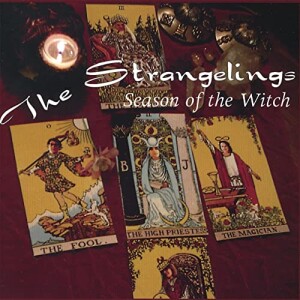 The electric sitar: Not just for George Harrison tunes.
The electric sitar: Not just for George Harrison tunes.
Okay, I’m in love. Electric sitar! Bliss! No, seriously. Not hyperbole: it’s love. I’m replaying one of my happiest discoveries in a season of catch-as-catch-can, the Strangelings CD Season of the Witch. And yes, that’s Donovan’s classic song, as redolent of the 1960s as anything short of “Purple Haze” could possibly be. The first three songs on the CD are covers, and they all work. Hoo boy, do they work.
The Strangelings, on first glance, are blink-inducing. They’re a folk-rock “super group” of sorts, anchored by Pete and Maura Kennedy of The Kennedys. A deeply layered set of vocal harmonies (three women singers — Maura, Chris Thompson and Rebecca Hall — each of them distinct), an eclectic taste in song choice (the CD includes everything from psychedelic-era covers to Appalachian overtones), and, well, there’s Pete’s electric sitar.
Like a lot of other people, if pressed, I’ll choose “Revolver” as the best Beatles album overall. I suspect, though, that my pick for best tune off that one is less common: George Harrison’s “Love You To.” That has a lot to do with the sitar, which brings back an era that gave me most of my favourite music.
The thing about electric sitar in a rock setting is that it can carry a riff as well as your basic Strat or Paul, if not better. It’s deeply, richly talkative. And when you partner it with three — three! — corking good vocalists, soaring instrumentation and a brilliant choice of setlist, it has a fantastic freshening effect on the songs in question.
That’s exemplified on the Strangelings’ cover of It’s A Beautiful Day’s classic ’60s ballad “White Bird.” The original is iconic: David LaFlamme, a superb violinist, had a symphonic background, and it showed in some subtle ways. The Strangelings, by bringing that electric sitar into the mix, take the familiar icon and give it an unearthly echo, made even deeper and more evocative by way of all those lovely vocals. I suspect that IABD’s original vocalist Pattie Santos, who died in the late ’80s, is out there somewhere, nodding in appreciation.
There are no weak spots on this CD, not one. The sitar makes itself felt in odd, delicious spots along the way: the beginning of “Wayfaring Stranger” first made me jump, and then grin like an idiot. It punches like a twisty little fist, providing emphasis for “Didn’t It Rain,” kicking the legs out from under the unsuspecting listener, who is already blinking at the a capella rap near the end of the song.
And of course, there’s the cover of “Matty Groves.” I stand firm in my love for Fairport’s Liege & Lief version. That’s a no-brainer: Richard Thompson, Dave Swarbrick, Sandy Denny, what’s not to love? The Strangelings’ cover has very much the same feel, with two small additions: one haunting memorable female vocal is now three. And of course, there’s that sitar.
Subtle touches, gorgeously layered vocals, a flying fiddle and wonderful musicians all the way round put this one into my heavy rotation. I wonder if I could talk them into covering Donovan’s “Barabajagal,” complete with the sitar taking over Nicky Hopkins’ piano part?
(The Strangelings, 2007)
